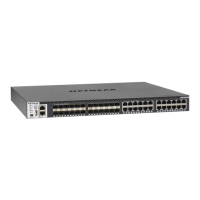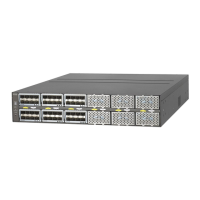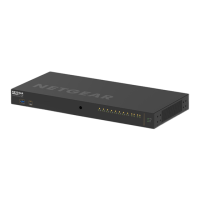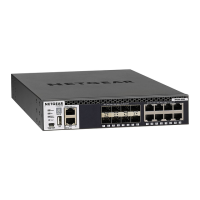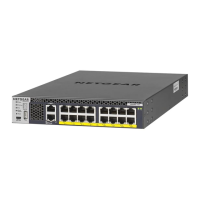Routing
221
M4100 Series Managed Switch
The entry corresponding to the specified interface is selected.
9. Use Port to select the interface.
10. Use Description to enter the description for the interface.
11. Use IP Address Configuration Method to enter the method by which an IP address is
configured on the interface.
There are three methods: None, Manual, and DHCP. By default the method is None.
Method None should be used to reset the DHCP method.
Note: When the configuration method is changed from DHCP to None,
there is a minor delay before the screen refreshes.
12. Use IP Address to enter the IP address for the interface.
13. Use Subnet Mask to enter the subnet mask for the interface.
This is also referred to as the subnet/network mask, and defines the portion of the
interface's IP address that is used to identify the attached network.
14. Use Routing Mode to enable or disable routing for an interface. The default value is enable.
15. Use Administrative Mode to enable or disable the administrative mode of the interface.
The default value is Enable. This mode is not supported for Logical VLAN interfaces.
16. Use Forward Net Directed Broadcasts to select how network directed broadcast packets
should be handled.
If you select Enable, network directed broadcasts are forwarded. If you select Disable,
they are dropped. The default value is Disable.
17. Use Encapsulation Type to select the link layer encapsulation type for packets transmitted
from the specified interface.
The possible values are Ethernet and SNAP. The default is Ethernet.
18. Use Proxy Arp to disable or enable proxy ARP for the specified interface.
19. Use Local Proxy Arp to disable or enable Local Proxy ARP for the specified interface.
20. Use Bandwidth to specify the configured bandwidth on this interface.
This parameter communicates the speed of the interface to higher-level protocols. OSPF
uses bandwidth to compute link cost. The valid range is (1 to 10000000.
21. Use ICMP Destination Unreachables to specify the mode of sending ICMP destination
unreachables on this interface.
If this is disabled, then this interface does not send ICMP destination unreachables. By
default, the destination unreachables mode is enabled.
22. Use ICMP Redirects to enable/disable ICMP Redirects mode.
The router sends an ICMP tedirect on an interface only if tedirects are enabled both
globally and on the interface. By default ICMP Redirects mode is enabled.
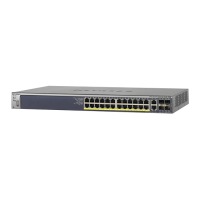
